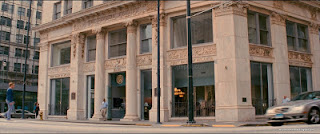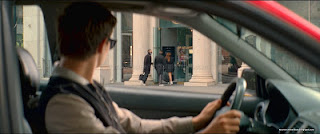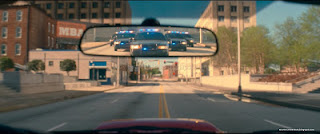The second film opening sequence I have decided to analyse is Baby Driver. It's very different to typical films as Edgar Wright created a film where the sound has been synchronised with the camera shots to give it a cinematic feel. The film follows the two different lifestyles lead by Baby, whose hearing is partially impaired because of a car accident he was involved in when he was younger. He works as a getaway driver for his boss, Doc, and he is also portrayed as a caring regular guy who looks after Joseph, his deaf foster parent. But just as he thinks he's finished and can have his life back Doc gives him one more job with violently unstable criminals which put him and Debora, his love interest, in danger.
The film begins with a wide shot from a low angle of a regular street only using muted cool tones to emphasise the bright red car which pulls up in front of the camera forcing a close up shot of the wheel. Already the main characters are easy to distinguish from each other with their colour coordinated
 outfits which become clearer later on. The film introduces
each character one by one with the beat of the music Baby plays
into his earphones. This is followed by a series of pan shots as the three walk
into the bank wearing sunglasses and bandanas to hide their identities. As they
disappear into the bank the camera cuts to Baby dancing and
singing to his upbeat music which suggests he is just a kid and emphasises
the contrast between him and the professional criminals suggesting that he
doesn't belong in the group.
outfits which become clearer later on. The film introduces
each character one by one with the beat of the music Baby plays
into his earphones. This is followed by a series of pan shots as the three walk
into the bank wearing sunglasses and bandanas to hide their identities. As they
disappear into the bank the camera cuts to Baby dancing and
singing to his upbeat music which suggests he is just a kid and emphasises
the contrast between him and the professional criminals suggesting that he
doesn't belong in the group. This cheerful atmosphere
quickly comes to an end when a police car rides past with its sirens on
and the music fades out. We then see Baby's point of view as he looks at
the chaos inside the ban. The music in the background is suppressed by the
screams within the bank showing Baby has lost focus on the music. As a
shot gets fired the music returns to it's normal upbeat rhythm and Baby
twitches as though he feels uncomfortable further emphasising that
he's not used to violence and doesn't belong with the criminals.
This cheerful atmosphere
quickly comes to an end when a police car rides past with its sirens on
and the music fades out. We then see Baby's point of view as he looks at
the chaos inside the ban. The music in the background is suppressed by the
screams within the bank showing Baby has lost focus on the music. As a
shot gets fired the music returns to it's normal upbeat rhythm and Baby
twitches as though he feels uncomfortable further emphasising that
he's not used to violence and doesn't belong with the criminals. After robbing the bank this
quickly turns into a chase scene where Baby shows off his unusually good
driving skills. The music is accompanied by the sounds of the car engines and
police sirens. This continues the well edited sound which make it pleasing for
the audience to watch. The chase scene continues for about three minutes before
the titles sequence starts.
After robbing the bank this
quickly turns into a chase scene where Baby shows off his unusually good
driving skills. The music is accompanied by the sounds of the car engines and
police sirens. This continues the well edited sound which make it pleasing for
the audience to watch. The chase scene continues for about three minutes before
the titles sequence starts.In comparison, this opening sequence grabs the viewers’ attention from the beginning whereas Hidden Figures is more relaxed and introduces character Katherine Johnson using a series of flashbacks into her school life. Baby Driver uses many cuts of actions scenes and as Hidden Figures is a historical drama the shots are longer.
Screenshots from: http://moviescreenshots.blogspot.com/2018/03/baby-driver-2017-part-1.html



